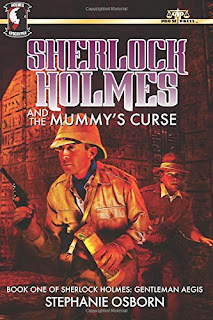 I have always loved Sherlock Holmes stories. As a teen, I
read The Hound of the Baskervilles
and was immediately hooked. As an adult, I continue to read or watch stories featuring
Holmes, whether from the eyes of Mary Russell (Laurie R. King) or those of the
modern day Sherlock in Stephanie Osborn’s The
Displaced Detective series. To date, I have been particularly enamored with
the contemporary BBC series featuring Sherlock Holmes, and anticipate each new
episode’s release.But now I have a new favorite – The Gentleman Aegis series, starting with book 1: Sherlock Holmes and the Mummy’s Curse.
I have always loved Sherlock Holmes stories. As a teen, I
read The Hound of the Baskervilles
and was immediately hooked. As an adult, I continue to read or watch stories featuring
Holmes, whether from the eyes of Mary Russell (Laurie R. King) or those of the
modern day Sherlock in Stephanie Osborn’s The
Displaced Detective series. To date, I have been particularly enamored with
the contemporary BBC series featuring Sherlock Holmes, and anticipate each new
episode’s release.But now I have a new favorite – The Gentleman Aegis series, starting with book 1: Sherlock Holmes and the Mummy’s Curse.
Readers like to be brought right into the scene when they’re
reading a book. They like to feel “present” in the moment, to feel the
character’s joy and discomfort, to hear the sounds of the forest, or to taste
the piquancy of a freshly made sauce. It’s not something a lot of writers can
pull off – but in this case, Ms. Osborn has accomplished this both elegantly
and with great style.
Part of the reason is because Ms. Osborn uses dialect and
phrases that match the decade in which her story takes place. The societal
norms, everyday phrases, science of the day, the medical treatments, the
objects, the clothing, food, the methods of transportation, even the curses,
are all genuine to the times. The research behind these elements must have been
gargantuan.
Another component that brought this story to life is the
richness of linguistics, in other words, the frequent phrases in unique
languages such as Portuguese, French, and Arabic. With a good set of footnotes
at the end, there is no doubt what each of these phrases meant. However, in
most cases it was easy to discern the meaning by the context in which the
phrases were used.
Now on to the plot and characters, both of which mesmerized
this reader. The local color of Egypt and the all-time favorite topic of
mummies, lost pharaohs, scarabs, ancient curses, and the like would be enough
to hook me. But add to that a splendid cast of offbeat and delightful
characters, each bent on their own agenda, and a wonderful unrequited love
subtheme, and Ms. Osborn has created a genuine treasure with this story.
The characters of Holmes and Watson were charmingly
delineated, each with distinctive voices and accompanying actions. Never for
one moment did I doubt that they were “real”; they convinced me from the very
first chapter. I rooted for them every step of the way, and could only relax
when they were safe and sound back in London, ready to chase their next
adventure.
(Click in book cover above for link!)
Aaron Paul Lazar
www.lazarbooks.com